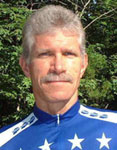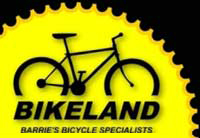|
How to Find a
'Safe Saddle' By |
 A bicycle saddle from when Grover Cleveland was in The White House. |
Since the late 1990s, saddle design has seen major innovation.
A big impetus came from a prominent doctor's contention that sitting on a bike seat might lead to damaged nerves or blood vessels in some men. This risk, plus the occasional bout of temporary genital numbness that many riders experience, put designers into action.
The result is a new generation of saddles with special shapes, padding or cutouts to reduce crotch contact and pressure. As a side benefit, riders have found that they experience fewer saddle sores on these seats.
Saddle selection is highly individual. Despite how effective a saddle might look or how highly praised it might be by a riding buddy, there's no guarantee that it will be comfortable for you. You need to ride it to tell.
Here are some selection guidelines, followed by two things you must do to further reduce risks and discomforts: (1) develop a good riding position, and (2) use smart riding techniques.
Saddle Selection
Width. Squat and sit on a low stool or curb. What you feel supporting your weight is your ischial tuberosities, the points of the pelvis that are commonly called the "sit bones." These are what should support your weight on a saddle.
A seat that's too narrow will place your weight on the soft tissue between your sit bones — for men, on the perineum where the penile nerves and blood vessels are located. Women also need to put a high priority on width because, on average, they have wider sit bones than men. Anatomically designed women's saddles are a bit wider in the main sitting area.
Curvature. Looked at from the rear at eye level, a seat should be flat or only very slightly domed. A significant curve causes your sit bones to be lower than the saddle's center, contributing to crotch pressure.
Dip. Looked at from the side at eye level, a seat should be nearly flat from nose to tail. A slight dip (say six degrees or less) is helpful to give you a feeling for the saddle's center while riding. More dip creates positioning problems. That is, when the nose is set level, the tail sticks up and may be uncomfortable to sit on; when the tail is set level, the nose goes up and exerts pressure right where you don't want it.
Padding. Some is good, more is not better. You want enough foam or gel to cushion your sit bones for comfort. Thick padding can actually increase crotch pressure because as your sit bones sink in, this has the effect of making the center press upward.
Special sections. These are what set the new generation of saddles apart. These sections range from gel-padded areas, to wedge-shaped cutouts, to holes through the top. Rider reactions to these innovations are all over the board. Do they lessen contact or pressure? No doubt. Do they absolutely, positively prevent numbness or worse problems? No saddle maker can guarantee that. Are they comfortable? It depends on whom you ask. The saddle that one rider swears by will be the same saddle the next rider swears at. There's simply no way of knowing until you ride on a given design.
Saddle Position
Please check with us for guidelines on adjusting your bicycle perfectly. We can set saddle height, tilt and fore/aft location. Of course, we don't stop at the saddle. We go though all of the steps to get an overall well-balanced riding position. We also check handlebar position, because if your saddle position is right but your handlebar position isn't, you still might run into problems.
TIP! For many guys, a saddle that's slightly off center (compared to the top tube) feels more comfortable. If the nose keeps pressing you in the wrong spot, try a bit of left or right angle. According to Andy Pruitt, Ed.D., who has refined the positions of many top cyclists, the right approach is always to make the bike fit your body instead of making your body fit the bike.
Riding Techniques
The rule is simple: Don't sit statically in one place for more than a few minutes. When you keep moving on the saddle, as well as on and off the saddle, you avoid constant pressure and compression. Blood keeps circulating, nerve transmissions keep flowing, and the risk of numbness is greatly reduced.
This is pretty easy to do off-road, where terrain changes and body English keep your crotch from locking into a set position. It's harder on a road bike unless you cultivate some good habits.
For example, get out of the saddle for at least part of every hill. Stand when exiting every turn or any other time you need to accelerate. Even just a few seconds is helpful when repeated often. On a ride in flat terrain, shift to a higher gear so you can stand and pedal out of the saddle for at least 30 seconds every 20 minutes. When sitting, keep your butt far enough back for your sit bones to be supported by the seat's wide rear section. Beware of the tendency to creep forward onto the nose and dwell there, especially when pushing hard or riding in a low position.
Other Pointers
If you use an aero bar, you'll tend to lock into a low, forward position for minutes on end. It's a nuisance, and it takes effort, to break this position to stand. But it's risky if you don't. Also, try to stay back on the wide area of the saddle. Tilting the nose down 1 or 2 degrees can reduce crotch pressure, but more will tend to make you slide forward onto the skinny nose.
Ride like a jockey when you come to anything rough. By leveling the pedals, flexing your knees and holding your butt an inch above the saddle, you'll avoid impacts that can cause bruising and pain. A shock-absorbing seatpost is another way to reduce the risk, but don't let it lull you into remaining seated all the time.
Carry stuff on your bike, not on your body. This isn't always possible, but realize that when you ride with a backpack, fanny pack or hydration system, you are adding weight to your seat. This makes a wide, supportive saddle even more important. The same goes if you're overweight.
Be smart when riding indoors. With no terrain changes or other natural opportunities to move your butt, you need to invent some. Pedal out of the saddle for one minute in every five. Consciously move to a different sitting area every couple of minutes. Keep sessions short and varied rather than long and steady. Using bigger gears lightens saddle pressure because your feet must push harder.
Wear high-quality, lightly padded cycling shorts. These, plus a skin lubricant such as Chamois Butt'r, increase comfort and reduce the risk of developing raw or tender spots. These can stop you from shifting position to all parts of your crotch and the saddle.
 This article is provided courtesy of RoadBikeRider.com and was written by its co-founder Ed Pavelka (left). Ed was the Executive Editor of Bicycling Magazine for a decade, has written many books on cycling including The Complete Book Of Long-Distance Cycling; and is a world-record-holding roadie.
This article is provided courtesy of RoadBikeRider.com and was written by its co-founder Ed Pavelka (left). Ed was the Executive Editor of Bicycling Magazine for a decade, has written many books on cycling including The Complete Book Of Long-Distance Cycling; and is a world-record-holding roadie.RoadBikeRider offers cycling books, many more cycling guides and even a free weekly e-mail newsletter full of tips and news for aspiring bicyclists. Receive a FREE copy of the eBook “29 Pro Cycling Secrets for Roadies” by subscribing today.
